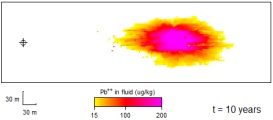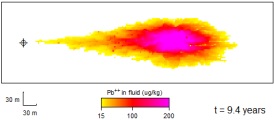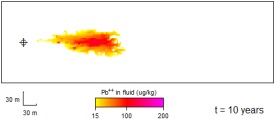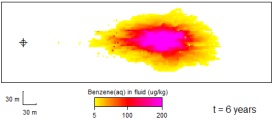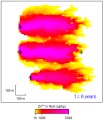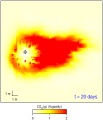Movies of reactive transport simulations
One of the most attractive aspects of GWB is the visualization features. I deal with a lot of people who are not familiar with a lot of chemical concepts—this is where moving pictures are so important.
– Nick Steven, Rockwater Consulting, Namibia
Click on the images below to watch short movies showing the results of reactive transport simulations traced using X2t, part of the GWB Professional release. The movies were created using the GWB program Xtplot with the "Save animation to image files" option checked in the Animate... dialog, then dragging the resulting image files into VSDC Free Video Editor.
If you have the GWB software installed, click on the X2t icon  underneath each image to download the input files for tracing the simulations shown. Where data icons
underneath each image to download the input files for tracing the simulations shown. Where data icons  or
or  appear next to the X2t icon, save all of the files to your desktop, then double-click on the X2t file.
appear next to the X2t icon, save all of the files to your desktop, then double-click on the X2t file.
This movie shows the results of X2t simulations of the migration of inorganic Pb through an aquifer. The contaminant, taken in the simulation as non-reactive, leaks into the aquifer over a period of one month and is entrained in the flowing groundwater.
The movie shows output from two simulations:
- One in which dispersion is taken as a Fickian process
- A second in which the dispersion arises from heterogeneity prescribed in the aquifer
In this video clip a dual porosity model accounts for diffusion into and out of stagnant zones in the aquifer. There are three simulations:
- A single porosity model for a uniform medium, for reference
- A dual porosity simulation in which stagnant zones with a characteristic dimension of 1 m occupy 40% of the aquifer
- The dual porosity model above, applied to a heterogeneous aquifer
Animations in this movie show a simulation of Pb2+ transport through a heterogeneous medium, accounting for contaminant attenuation by sorption to the aquifer solids. There is a series of three simulations:
- The non-reacting case, for reference
- The lead ions sorb according to a distribution coefficient Kd
- Sorption follows a Freundlich isotherm
This clip follows a plume of benzene contamination as it moves through a heterogeneous aquifer and is degraded by the microbial community there. The simulations show:
- The non-degrading case, for reference
- The case of biodegradation in the absence of sorption
- A simulation in which the benzene both sorbs and biodegrades
In the simulation three tanks leak water contaminated with heavy metals into an aquifer for 10 years. At that time, the leaks are controlled and an extraction well begins operation.
Three metals – Hg2+, Pb2+, and Zn2+ – sorb in the run according to a surface complexation (two-layer) model, and Br– serves as a non-reactive tracer.
Hot water in this movie is injected into a petroleum reservoir, in order to stimulate production. The steam flood reacts with kaolinite, calcite, and quartz in the formation to produce swelling clay (beidellite) and CO2.
The animations in the clip show variation over the course of the flood in:
- Temperature
- CO2 fugacity
- Percent swelling clay
- Formation permeability, accounting for the clay produced
